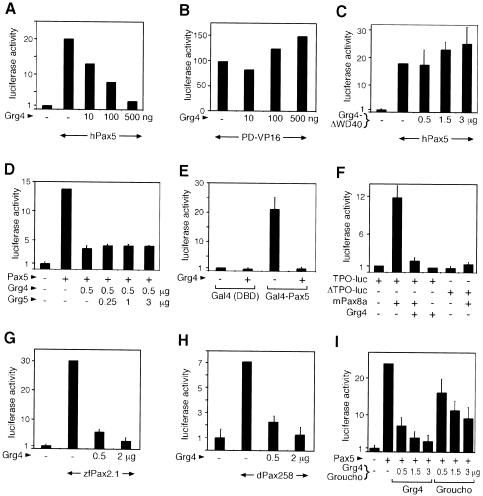Fig. 7. Grg4 represses the transcriptional activity of Pax5. The Pax expression vector (0.5 µg), luciferase genes luc-CD19 (5 µg) and pRL-SV40 (0.4 µg), and increasing amounts of the indicated Grg expression vector were used for transient transfection of SP2/0 cells (A–D and G–I). The amount of expression plasmid was equalized by the addition of pKW2T, and all data were evaluated as described in the legend to Figure 3A. Normalized luciferase values of one representative experiment (A and B) or three independent transfections (C–I) are shown relative to the luciferase activity measured in the absence of the Pax protein. (A) Repression of the Pax5 transactivation function by Grg4. (B) Failure of Grg4 to repress the function of a paired domain (PD)-VP16 protein. (C) Inability of the Grg4-ΔWD40 protein to repress the transcriptional activity of Pax5. (D) Grg5 fails to antagonize Grg4-mediated repression of Pax5 activity. (E) Repression of a chromatinized reporter gene by Grg4. Expression vectors (1 µg) encoding Gal4–Pax5 or the Gal4 DNA-binding domain (DBD) were transfected together with a Grg4 expression plasmid (0.5 µg) into U2-OS cells containing an integrated luciferase gene, followed by luciferase analysis as described (Alkema et al., 1997). (F) Grg4-mediated repression of the rat TPO promoter. HeLa cells were transfected with mPax8a (0.1 µg) and Grg4 (0.5 µg) expression plasmids and the luciferase gene TPO-luc (2.5 µg) and pRL-SV40 (10 ng). ΔTPO-luc contains a mutated Pax8-binding site (Zannini et al., 1992). (G and H) Grg4-mediated repression of the tran scriptional activity of zebrafish zfPax2.1 and Drosophila dPax258. (I) Repression of the Pax5 transactivation function by Drosophila Groucho.

An official website of the United States government
Here's how you know
Official websites use .gov
A
.gov website belongs to an official
government organization in the United States.
Secure .gov websites use HTTPS
A lock (
) or https:// means you've safely
connected to the .gov website. Share sensitive
information only on official, secure websites.
